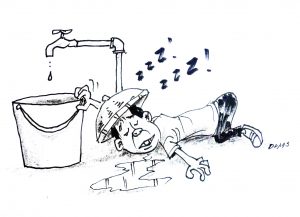We may not yet be experiencing the intense onslaught of the reported upcoming drought as rains still visit as now and then, but as early as now when prolonged droughts have not been experienced, many parts of our region are already enduring the scarcity of water supply, depriving the people of this vital necessity.
Our region is known for its abundant water sources, thick rainforests, and bountiful nature. Ironically, the region is facing this significant challenge—insufficient water supply. Many parts of Eastern Visayas, especially the urban areas, are struggling with little to no water access, the people spending sleepless nights waiting for the water to flow from their faucets. This lack of sufficient water supply is a pressing issue with far-reaching consequences for the communities.
One of the main reasons for the insufficient water supply in Eastern Visayas is the lack of infrastructure and facilities for water storage and distribution. The region’s topography, with its mountainous terrain and scattered communities, makes it difficult to implement water supply systems effectively. As a result, many households rely on unsafe water sources such as rivers and wells, leading to waterborne illnesses and health hazards. The government and local authorities must invest in water infrastructure projects to provide a sustainable solution to this problem.
Climate change also plays a significant role in depleting the water supply. The region is prone to erratic weather patterns, including prolonged droughts and typhoons, which can disrupt the water supply. These extreme weather events not only affect water sources but also damage existing infrastructure, further limiting access to clean water. Adaptation strategies, such as rainwater harvesting and efficient water management practices, are necessary in mitigating the impacts of climate change on water supply in the region.
This issue of insufficient water supply in Eastern Visayas requires prompt action, involving approaches such as investments in infrastructure, climate-resilient water management practices, and community participation. The government, non-governmental organizations, and other stakeholders must work together to ensure that all residents have access to safe and reliable water sources. Let’s prioritize water security and sustainability to overcome this challenge and improve the health and well-being of our water consumers.




